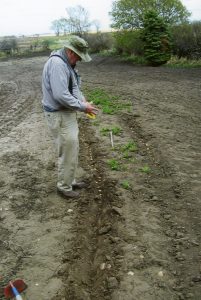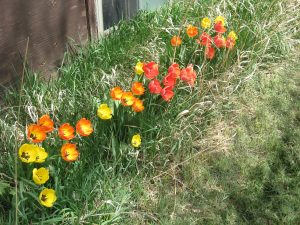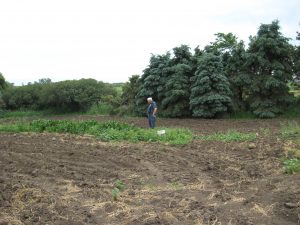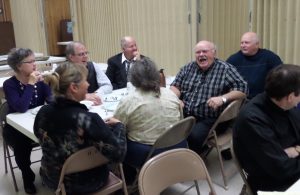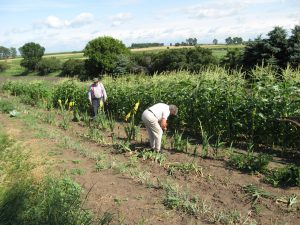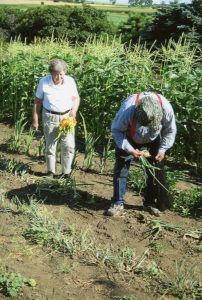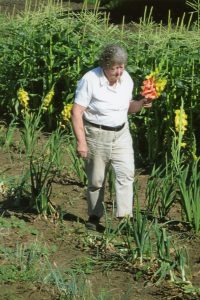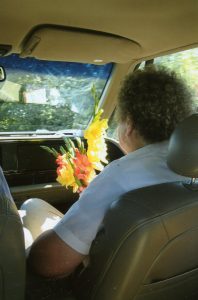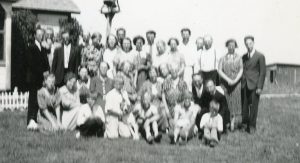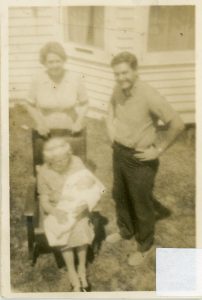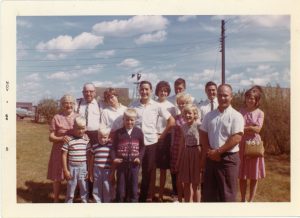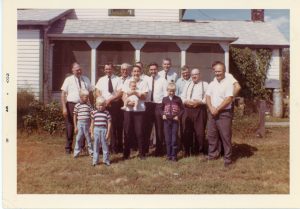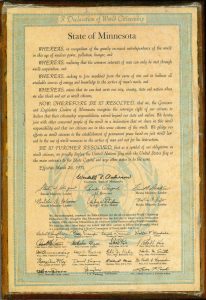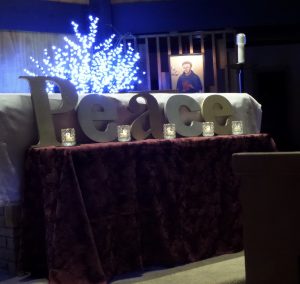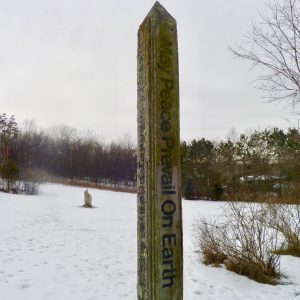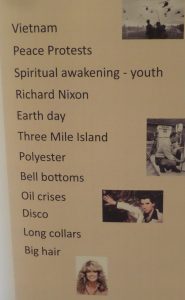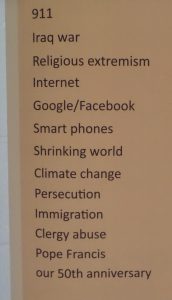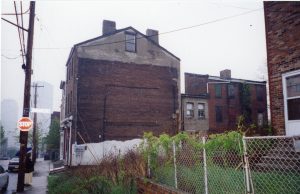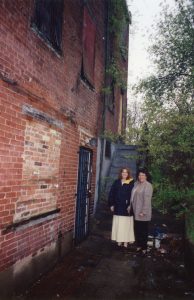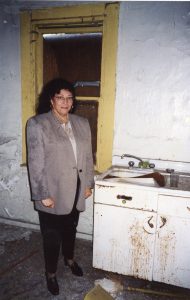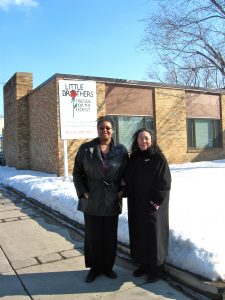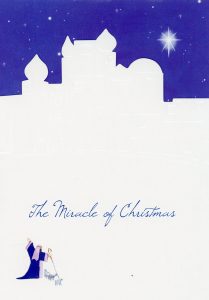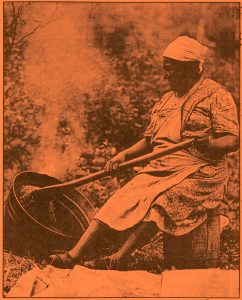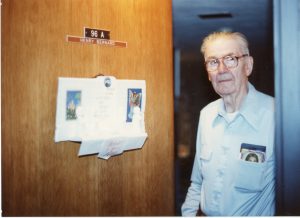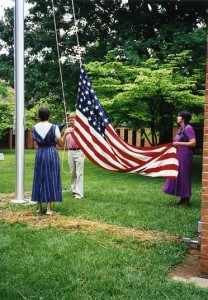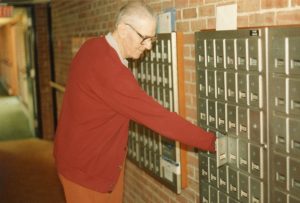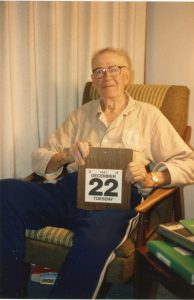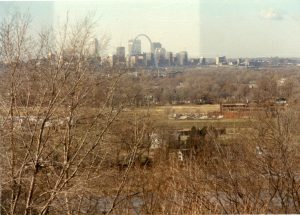Thoughts on the final day of 2016.
Remembering a North Dakota farm family.
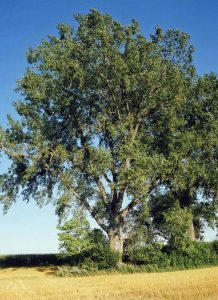
(click to enlarge any photo)
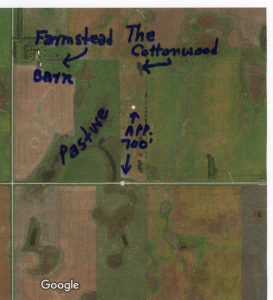
Since 1934 an impressive cottonwood tree has stood watch over the former Busch farm between Berlin and Grand Rapids ND. I took the above photo, and wrote a story about the tree in 2005. The story is accessible here.
A few blocks to the west of the tree stands a piece of pastureland, which, 106 years after the prairies became a farm, has yet to see a plow. For reasons only my Uncle Vince knows, this pasture was a very important piece of ground to him, even though it was only a small part of the farm.
This was a pasture well known to Vince and Edithe’s parents and brothers and sisters, going back to the beginning of the farm in 1905; and known to any of their nephews and nieces who visited on occasion. We became familiar with “cowpaths” and the lane from pasture to the barn, and if old enough we could watch the cows being milked by hand, and even try our hand at milking. In a sense, the cows were part of physical life of the Busch place, the milk cows with names.
For most of its years it was pasture for a few milk cows. Here is a photo from the 1940s labeled Aunt “Edithe’s favorite milk cow.” Unfortunately, the cows name isn’t included; most certainly she had a name.
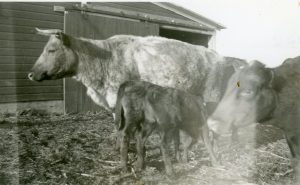
“Edithe’s favorite milk cow”, 1940s
My first vivid memory of the pasture is in the winter, sometime in the 1940s, watching what seemed to be
gigantic white rabbits loping across snowdrifts. It wasn’t an illusion:
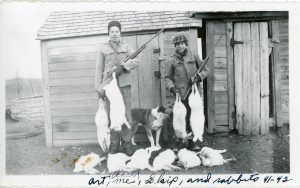
Uncle Vincent and Uncle Art with a productive hunt for rabbits, sometime in 1941-42.
Over the years, the rabbits disappeared, for some reason never explained to me.
As for the cows, we grandkids, who showed up from 1940 on, knew the drill: Twice a day, cows came home via the cowpath – force of habit, I guess – with a lead cow. Here’s an old slide from Nov. 1980 showing my Uncle and cousin Mary Kay. (double click to see the cows in the background, or a closer view of the cowpath)
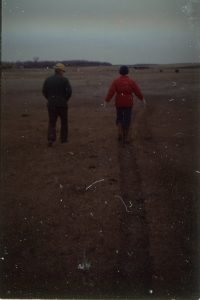
Uncle Vince and Cousin Mary Kay (on a cowpath in the pasture, Nov. 1980)
In my growing up time, there were maybe 10-15 cows maximum, milked by hand twice a day, later usually by Edithe and Grandma Rosa. Kids were allowed to try milking, but it was hard work – the fun wore off very quickly. Cats hung around for a possible treat. Once in awhile a cow “kicked the bucket” partly full of milk, probably the origin of the saying about dying.
The cream separator initially was hand-powered. Cream and milk would be kept in cans, and kept cool in a water tank by the door of the barn. For years, Uncle Art kept the old separator; later he gave it to me; I think my sister has it now…”antiques” have their day…a nuisance, but yet a reminder of what once was.
I can remember the tedious job of hand-churning cream to make butter: the butter didn’t just magically appear. We kids didn’t have the patience, I’d guess. But once in awhile you could actually see the butter begin to appear.
Once in awhile we might be there when a truck came from LaMoure to pick up the milk and cream. In LaMoure was a small Land-o-Lakes Creamery which made things like butter and, perhaps, ice cream. At least once I can remember a visit to the creamery. Every time, however, we stopped at the Dairy Bar in the same building (photo below) for ice cream. Successive renditions of that Dairy Bar continued until very recently. I think it’s now closed.
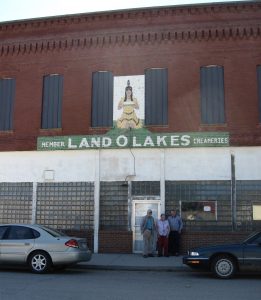
LaMoure ND June 28, 2009. Edithe, Vincent and Dick Bernard at what used to be the Creamery and the Dairy Bar in LaMoure. We all appear to be tired. Must have been a busy day.
I can’t fix a date when the Busch’s stopped milking. It probably came sometime in the 1960s, before Grandpa died, and by then Grandma was in her late 70s. There quite likely was an extended period without cows in the pasture. Someone could correct me on this.
Beginning about 1980, Uncle Vincent began to graze a small herd of beef cattle in the pasture. This lasted until the bad winter of 1996-97, when snow conditions and his own advancing age made it impossible for Vincent to take care of the cattle. On occasion one or another of us would go with Vince to the pasture. The cattle were familiar with him; for strangers, particularly if there was a newborn calf nearby, extreme caution was advised. Mama’s cottoned no nonsense. Strangers were a threat.
After 1997, for reasons known only to Vince, this particular piece of pastureland lay unused, except he allowed a neighbor to cut and bail the hay for a fee.
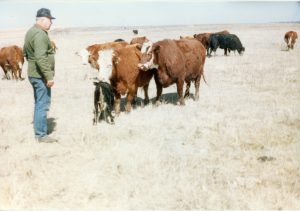
Vincent in the pasture spring of 1987, photo by his sister, Edithe.
From 2006 on, Vince and Edithe lived in LaMoure, and the trips to the farm normally did not include the pastureland.
But in early October of 2012, just about a month or so before Aunt Edithe went into the Nursing Home in LaMoure, Uncle Vince felt a need to go out to that pasture one last time, and that we did, on a very breezy and chilly North Dakota fall afternoon. It would have been wiser to stay home, but Vincent was determined, and we went.
This particular day, Vince had his mind set on pieces of tin on an old feeding station out in the pasture, and we set about successfully taking off the roof, later to be used to cover a broken window or two on an old shed on the farmstead.
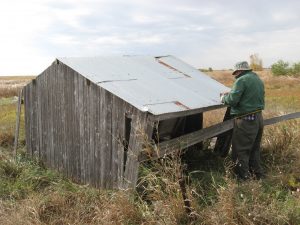
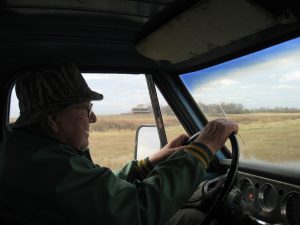
October 4, 2012
The farm has now been sold, and the young couple with three young children who now own the farmstead and have a contract to purchase the pasture in a given time period. When I was at the farm in early October, I saw the two calves who, by next summer, will bring farm life to the pasture, as the family is rebringing life to a rural North Dakota farmstead.
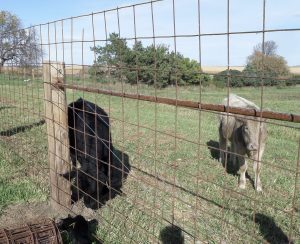
Two young calves outside the Busch barn, Oct. 6, 2016
Uncle Vince would be pleased, of that I’m certain.
As this year ends, and a new one begins, what do you remember about your growing up years when your life was being formed?

Busch barn, rural Berlin ND, May 24, 2015 at approximately 100 years old.
, Uncle Vince’s grand-nephew Jan. 3: Hi Dick..Hope you had a Merry Christmas.This is Jon Busch..Don’t know what you know about the pasture land..But in my few conversations with Uncle Vince with my dad alive the land where the pasture is has never been tilled for crops (native prairie). It was grazed by livestock many years ago. Also there is a native American burial ground at or near the farm..Not sure if nearby or on their property no idea if that would be the pasture? Or mounds? Elsewhere.. Thanks for all of the time you guys spent working on this stuff. Have a happy new year…Jon
Response to Jon from Dick: Over the years I’ve gotten to know a great deal about this particular piece of pastureland, primarily many visits with Vincent, which is a main reason I’ve endeavored to deal very carefully with it, particularly carving it out as a specific parcel of the property. It is a legacy of the family. It was very, very important to Vince, for some reason; more so than even the surrounding long-tilled land which was more valuable. Your Grandpa George, Vincent’s older brother, as you doubtless know, had a great affinity for this land as well.
The Indian mound(s?) of which you speak were a short distance north of the Busch property – to the north of what I call the Grand Rapids road. I do not know much about them, except they existed and (probably) weren’t respected by someone or other over the years. The Busch farm sits very near the western edge of the James River, and no doubt saw a great deal of Native American activity in pre-white settlement, which primarily came with the railroad about 1880 or so.
Over my life-time, now nearing 77 years, the size of the usable pasture land decreased as it is part of a watershed which, when combined with the natural consequence of wetter years, and drainage by farmers upstream, increased the permanent wetland. The gate to what we used to know as the south pasture has long been unusable and I think the south boundary of the property has been somewhat difficult to fence because of the water issue.
Thank you very much for your comment.
from Fred: This is an excellent, evocative and thoughtful study. It brought to life a different time, one with which I can identify — there were farmers in my family too. Very nicely done.
from Joe: I read and greatly enjoyed your essay about the pasture and your excellent 2005 story about the old cottonwood tree. Thanks for both.
from Gail: Good story. Even better, it’s true.
from Shirley: Another “so-very-interesting” piece! Thanks.
from David, whose Mom grew up on the then-adjoining farm: I still recall that great old barn.
from Leila: One of my relatives had an old barn near Forman that withstood all kinds of severe storms when others didn’t. He claimed that it was because air could move easily through all of the gaps in the roof and walls.
Response from Dick: It makes sense. They do get very strong and frequent winds out there! Often! There is another factor with this particular old barn. About the first day of August of 1949, the roof blew off the 1915 barn during a big windstorm. As a matter of fact, we were staying in the house, 200 feet away, that very night. It was a scary evening to say the least. I was 9, and I remember the fright of the night! There was lots of damage in LaMoure County. Re the barn itself, all that was lost was the entire roof; even the floor of the hayloft was intact. My Dad, being a schoolteacher and on summer break, stayed and helped build new roof beams, one at a time. My Grandpa had made the form, based on a barn he saw in the area. The construction of the beams was by hand and thorough. It is also possible that the roof itself, at least to this point, buttresses the rest of the structure, but that will change unless it is re-roofed. Without extensive and very expensive renovation, the barn will not be saved. Most likely, I would guess, someday we will see a pole barn for the small herd the new owners of the farmstead hope to have. It is an interesting process.
from Jo: Your farm story brought back my entire childhood until I turned 17 and came to [college]. I can read paragraph after paragraph of your story and it so resembles my story. We had a huge red barn which also went with the wind. It lifted the roof and haymow over the house we lived in and set it down on the pasture past us. This haymow we used to swing out over and drop into the hay that had been brought in by a team of horses and hayrack and pulled up to the huge opening with a chain which the horses pulled up (the sling hooked unto the dropped down part). When that load of hay was in the proper part of the haymow, a trip rope would trip the catch and it would drop unto the haymow floor. It took many trips with that hayrack, (each held 2 slings) to fill that large area. There were holes to throw down the hay into each stall below where the milk cows stood. For safety sake, I am sure, each hole was surrounded with about a 5 foot tall box around it with a lid. Harder to put the hay down as have to be lifted up before going down. Our cream cans were not picked up, they were driven to the Casselton Creamery by us. As we waited for them to be processed, our great and always anticipated joy was to order and savor an ice cream malted milk. They probably cost 10 cents or a quarter.
Our pasture was filled with large cottonwoods under whose shade in summer we would sometimes picnic. One of the first “jobs” I had was to help to drive the milk cows to the “North Pasture”. It was through the regular pasture and over the railroads tracks so there was a gate to get over the tracks and one to get into the N. pasture with due diligence paid to making sure there was no train either way. Not being old or big enough to open those gates, pulled shut with a barbed wire round, I was the chaser for cows that started other ways.
So thanks for triggering some very old memories. Life is so far from that now. Thank goodness.
from Dick, in addition: Thanks very much for this. We are old enough, now, I’d guess, to admit that we had our feet pretty deep in what truly were “the old days”. We just came to the farm to visit, but because we moved so much (my folks were both small town school teachers), the farm really became a “home town” in a very real sense of the word for me. They didn’t get electricity until the very late 1940s, so a wind charger did that duty; Grandpa was the rural telephone guy (“three longs and a short”, and perhaps 20 parties could “rubberneck” on calls), that sort of thing. But it was a good, solid upbringing for us.
*
Below are two photos, one after the storm, and one of the beams. You can click twice on them and see a closer enlargement.
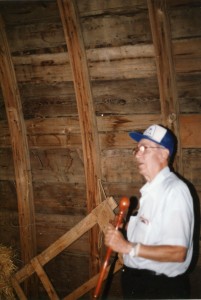
Henry Bernard in the hay mow June, 1991, standing by the roof beams he helped construct in 1949.
Look closely at the below and you can see all five Bernard kids, including John, who was then a year old. Plus Mary Ann, Florence, Frank and Richard. Henry is hidden behind Richard.
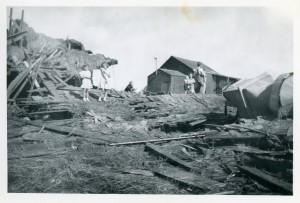
The Bernard kids the morning after the barn went down, summer 1949. Richard (Dick) is the kid facing away from the camera.

